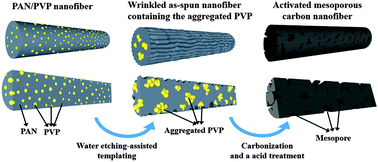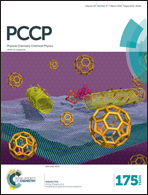Activated mesoporous carbon nanofibers fabricated using water etching-assisted templating for high-performance electrochemical capacitors†
Abstract
Activated mesoporous carbon nanofibers (AMCNFs) are synthesized by a sequential process of electrospinning, water etching-assisted templating, and acid treatment. Their morphologies, crystal structures, melting behavior, chemical bonding states, surface properties, and electrochemical performance are investigated for three different polyacrylonitrile (PAN) to polyvinylpyrrolidone (PVP) weight ratios – PAN : PVP = 8 : 2, 7 : 3, and 6 : 4. Compared to other samples, the AMCNFs with an optimum weight ratio of 6 : 4 show the highest specific surface area of 692 m2 g−1, a high volume percentage of mesopores of 43.9%, and an increased amount of carboxyl groups (10.5%). This results in a high specific capacitance of 207 F g−1, a high-rate capability with a capacitance retention of 93%, a high energy density of 24.8–23.1 W h kg−1, and an excellent cycling durability of up to 3000 cycles. The electrochemical performance improvement can be explained by the combined effect of the high surface area relative to the increased electrical double-layers, the high volume fraction of mesopores relative to shorter diffusion routes and low resistance pathways for ions, and the increased amount of carboxyl groups on the CNF surface relative to enhanced wettability.


 Please wait while we load your content...
Please wait while we load your content...